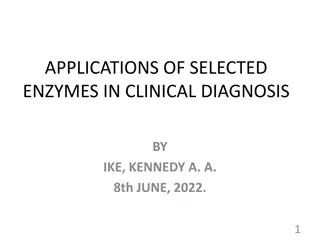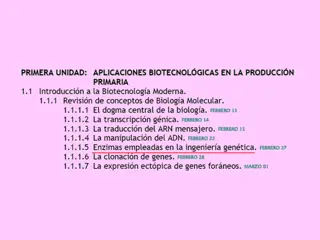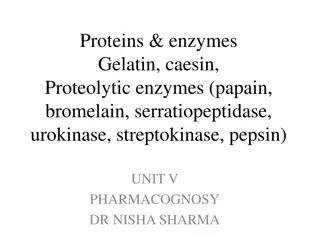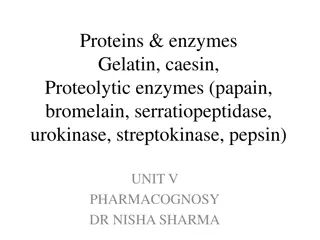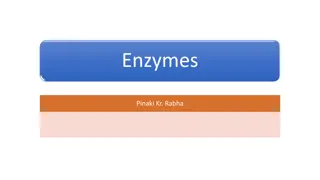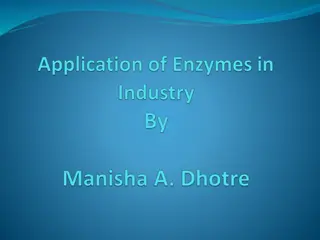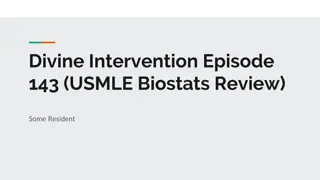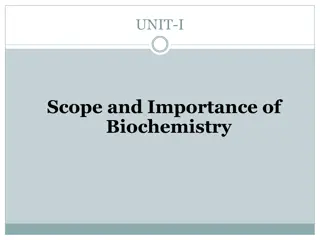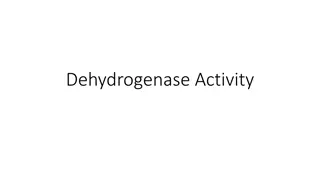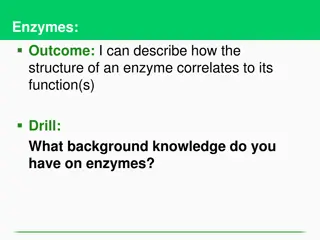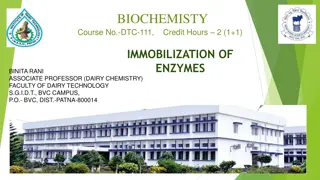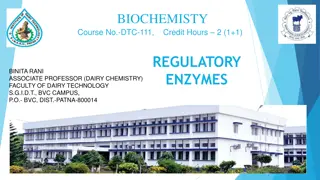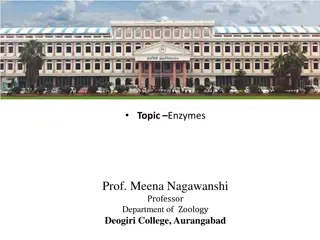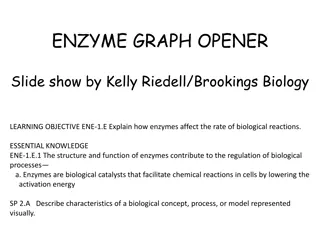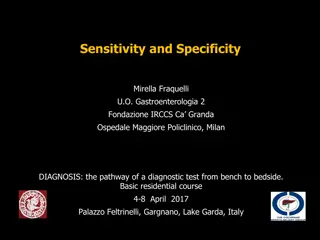Understanding Enzymes in Biochemistry: Properties, Specificity, and Regulation
Enzymes are biological catalysts that accelerate biochemical reactions without being altered themselves. They exhibit specificity by binding to particular substrates at active sites to convert them into products. Enzymes can be regulated to match the cell's needs, either through activation or inhibition. This comprehensive guide covers enzyme properties, classification, nomenclature, and factors affecting their activity, along with clinical applications in disease diagnosis.
Download Presentation

Please find below an Image/Link to download the presentation.
The content on the website is provided AS IS for your information and personal use only. It may not be sold, licensed, or shared on other websites without obtaining consent from the author. Download presentation by click this link. If you encounter any issues during the download, it is possible that the publisher has removed the file from their server.
E N D
Presentation Transcript
437 Biochemistry Team Enzymes and coenzymes 1 Color index: Doctors slides Notes and explanations Extra information Highlights
Objectives: Understand how enzymes are able to speed up the rate of biochemical reactions in the body Identify classes of enzymes based on the type of reactions they catalyze Comprehend the basic terms of coenzymes, isoenzymes, enzyme activity and specificity along with factors affecting their activity Understand the enzyme kinetics, types of inhibition and regulation of enzyme activity Discuss the clinical role enzymes in the diagnosis of diseases
Titles: 1. What are enzymes? 2. Enzyme properties and specificity 3. Enzyme-substrate binding Lock and key binding Induced fit binding 4. Classification of Enzymes 5. Enzyme nomenclature (Naming) 6. Holoenzymes 7. Cofactors and Coenzymes 8. Ribozymes, Isoenzymes and zymogens 9. Enzymes decrease activation energy of a reaction 10.Enzyme Activity or Velocity 11.Factors that affect enzyme activity 12. Enzyme kinetics
Everything that ends with ase is mostly an enzyme Properties of Enzymes What are Enzymes? Enzyme specificity Active site biological catalysts that speed up the rate of a reaction without being changed in the reaction The region of enzyme that binds with the substrate and where catalysis occurs All enzymes have one or more active sites -Enzymes are highly specific -Interact with only one or a few of the substrates Depending on the number of active sites -Catalyze only one type of reaction Enzymes must at least have one active site Specificity All enzymes are protein in nature All proteins are not enzymes Enzymes bind to their specific substrates in the active site to convert them to product(s) not every substrate can bind to any enzyme Substance upon which the enzymes act are called substrates Enzyme converts substrates into product(s) Regulation Enzymes can be activated or inhibited so that the rate of product formation responds to the need of the cell e.g. if we didn t eat food, we don t need digestive enzymes, therefore they are inhibited If we need to do another reaction to the same substrate, we use a different enzyme Catalysts: anything that speed up a reaction and not being changed in the process Example: Sucrase enzyme only interact with sucrose and only do one reaction which is hydrolysis thus breaking the bond and releasing fructose and glucose as products. If we needed to do another reaction, we use another enzyme
Structure of trypsin enzyme An enzyme with its active site Structure of pepsin enzyme Structures are not for memorization
Enzyme-substrate binding Classification of Enzymes Lock and key binding Induced fit binding Classified into six types according to the reaction catalyzed Oxidation-reduction reaction Oxidoreductas es The enzyme has a similar shape to the substrate, After the binding of substrate, the enzyme changes its shape to fit more perfectly with substrate The enzyme has an active site that fits the exact dimensions of the substrate Transfer of functional groups Transferases Hydrolysis reaction Hydrolases Group elimination to form double bonds Lyases Isomerization Isomerases Bond formation coupled with ATP hydrolysis Ligases ** Overseas travelers heard lyrics in london
Enzymes Nomenclature (Naming) Enzymes nomenclature is based on the rules given by IUBMB (International Union of Biochemistry and Molecular Biology). Nomenclature order is: Class.Subclass.Subsubclass.Enzyme number. EC 3.4.17.1 (carboxypeptidase A) You don t have to memorize this name just know what each number means. Enzyme commission Class Subclasses Enzyme number Sub- subclass
Holoenzymes Inactive enzyme that binds to a nonprotein part to become active Some enzymes require non-protein groups to become active The inactive form of enzyme without its non-protein part is called an apoenzyme NonProtein part Cofactor or coenzyme Holoenzyme (Active) = + Apoenzyme (Inactive) e.g. _______ e.g. _______ Transiently= temporary
Ribozymes, isoenzymes and zymogens Ribozymes Zymogens Isoenzymes Inactive enzyme precursors that require a biochemical change to become active (activated when needed) e.g. cleavage of peptide blocking the active site Enzymes that catalyze the same chemical reaction but they have slightly different structure RNAs (ribonucleic acid) with enzyme activity e.g. protein kinase have a multiple isoenzymes that are structurally different but share the same function enzymes involved in digestion like trypsin, pepsin and chymotrypsin are synthesized as zymogens because we don t need them all the time. Zygomens are a group of proteins that display no catalytic activity but are transformed within an organism into enzymes
Enzymes decrease activation energy of a reaction In every chemical reaction, the reactants pass through a transition state that has greater energy than that of the reactants or products alone The difference in energy between the reactants and the transition state is called the activation energy (Ea) If the activation energy is available then the reaction can proceed forming products An enzyme reduces the activation energy required for a reaction It provides an alternative transition state of lower energy called the enzyme-substrate complex and thus speeds up the reaction Enzymes decrease the activation energy but they do not alter the change in the free energy ( G)
The effect of catalyst on the transition state diagram of a reaction catalysts lowers the energy required to reach the transition state which make the formation of a product faster but it doesn t change the free energy Free energy change of the reaction is the difference of reactants and products.
Enzyme Activity or Velocity . Velocity is the rate of a reaction catalyzed by an enzyme- Enzyme activity is expressed as - mmoles of product formed/min/mg enzyme How many substrates were converted into products for a unit time Millimoles / min / milligram Or Micromoles / min / microgram Always use the same unit
1) Effect of temperature: Every enzyme has an optimal temp. for catalyzing a reaction (In humans most enzyme have an optimal temp. of 37C ) The rate of an enzyme reaction initially increases with rise in temperature. At high temp. enzymes are denatured and become inactive. In humans, most enzymes have an optimal temp of 37 c rate of reaction ) (
2) Effect of pH: Every enzyme has an optimal pH for catalyzing a reaction Most enzymes have highest activity between pH 6 and pH 8 Pepsin (digestive enzyme in the stomach) has highest activity at pH 2 Optimal Effect of temperature and pH
3) Effect of [E]and[S]: The reaction velocity increases initially with increasing [S] Until excess substrate causes the reaction velocity to be constant *Further addition of substrate has no effect on enzyme velocity (v)* (because enzyme is saturated). - - If [S] > enzyme => the rate of enzyme reaction will be directly proportional to the concentration of enzyme. [E] [E] [S] - At low [S], the reaction rate is proportional to [S] -At limited substrate (substrate is constant) ; the velocity depends on the concentration of the enzyme -At limited enzyme concentration (number of enzymes is constant) ; the velocity depends on the substrate concentration Effect of [E]and[S]
Enzyme kinetics Initial rate of enzyme reaction The time they take to get arranged 1. Pre-steady state: Enzyme + high concentration of substrate= an initial short period of time (a few hundred microseconds) during which intermediates of products gradually build up..NO PRODUCT DURING THIS PHASE. Enzyme-substrate complex formation only The model of enzyme kinetics was first proposed by Michaelis and Mentenin 1913 and later modified by Briggs and Haldane. The Michaelis Menten equation describes the relationship of initial rate of an enzyme reaction to the [S] Initial rate= when nothing is limited product 2. steady state: occurs after initial state, when the reaction rate and the concentration of intermediates change slowly with time An intermediate changes into steady state when the rate of its synthesis becomes equal to its rate of degradation. Enzyme very useful video :) very useful video :)
an additional slide TEAM 436
Michaelis Menten Equation It measures the initial velocity (vo) of an reaction enzyme Vmax [S] vo= ------------ Km + [S] [S] = substrate concentration Vmax = maximum velocity Km = Michaelis constant You might be asked to either find (Vo, or Vmax, or Km or [S] ) using this equation
Initial velocity Vo of a simple Michaelis Menten reaction- versus the substrate concentration Saturation
Km(Michaelis Constant) You must know the definitions. Kmis the substrate concentration at which the initial rate is one-half of the maximum rate ( Vmax) It is the [S] (substrate concentration) required to saturate half of all of the active sites of an enzyme Affinity= tendency to bind to a substrate The Kmvalue of a substrate depends on its affinity with the enzyme High Kmmeans low affinity with enzyme (more substrate needed to saturate the enzyme) Low Kmmeans high affinity with enzyme (less substrate needed to saturate the enzyme)
Lineweaver-Burk plot Definition Also obtained Michaelis Menten equation called the taking double-reciprocal reciprocals plot, the by of Usage: It is plotted to calculate the Km and Vmax values and to determine the mechanism of action of enzyme inhibitors 1 2
The graphs are for further understanding, but you should be able to recognize each graph. Initial velocity Vo of a simple Michaelis Menten reaction- versus the substrate concentration Lineweaver-Burk plot
Mcq: Which of the following statements about enzymes or their function is true? A. Enzymes do not alter the overall change in free energy for a reaction B. Enzymes are proteins whose three-dimensional form is key to their function C. Enzymes speed up reactions by lowering activation energy D. All of the above An enzyme is a-lipid b-cabrohydrates c-protein d-nucleic acid Enzymes having slightly different molecular structures but performing identical activity are: a) holoenzymes b)apoenzymes c) isoenzymes d) coenzymes Answer: c Answer:c Answer: D The Michaelis constant depends on? Which factor is responsible for inhibition enzymatic process during feed back? a) Enzymes b) End product c) Temperature d) Substrate The term apoenzyme is applicable to a) Simple enzyme b) Protein part of conjugate enzyme c) Organic cofactor of a conjugate enzyme d) Inorganic cofactor of a conjugate enzyme a) The affinity of an enzyme to a receptor. b)The concentration of substrates. c)The affinity of a substrate to an enzyme. d)The dissociation rate of a substrate to an enzyme. `Answer :c Answer: b Answer: b
BOYS TEAM: GIRLS TEAM: Team leaders: - Contact us: teambiochem437@gmail. com For editing file: https://docs.google.com/p resentation/d/16yNcm2Y0 8Cr0Am83lDRfH5NB4F1 ng3tdHiB3O1AqMc8 -





